Common Core. These two words trigger much debate and even speculation across the country in the field of education. Whether you, your school or your state is for, against, impartial or somewhere else, the skills and strategies endorsed in the Common Core State Standards (CCSS) are everywhere. Part of my job is to look at state and local standards, and I’ve noticed that the same ideas from the ELA standards in Common Core consistently show up in state and district standards too. Sometimes these standards are more specific than the CCSS and sometimes they are exactly the same.
These standards encourage critical thinking, creativity and interpretation. They are sometimes considered rigorous and challenging. But I think they are simply outlining the skills that are needed in today’s world—skills that we as teachers must model daily through engaging and thought-provoking book titles. By modeling these consistently, students learn to interpret, create and critique collaboratively or independently.
Graphic Novels and the Common Core
Graphic novels are a great place to start at the beginning of a new year. Graphic novels appear to be nonthreatening. They appeal to even the most reluctant reader and typically can be read quickly. Using them as a shared reading early in the year provides the class with a common reference throughout the year.
While I’m using my favorite graphic novel, El Deafo (Grades 5-8), as an example of the ease of Common Core integration, the same principles and activities can be used with any graphic novel. The websites I mention below are also listed on El Deafo’s Teacher Resource.
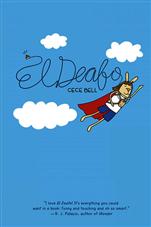
|
Graphic novels are in and of themselves a great example for standard 5, analyzing the structure of the text.
Similar to a book written in verse or as a screenplay, the structure of a graphic novel provides meaning. It is through the size of the panel, the details in the illustration and the dialogue among characters that creates the story.
In El Deafo, a graphic novel memoir by Cece Bell, Cece chronicles her hearing loss and her experiences at home and at school wearing her large and awkward hearing aid. Cece’s voice is powerful and true. Her life as a young girl trying to find friendship and fit in is laugh out loud funny at parts and incredibly emotional at others.
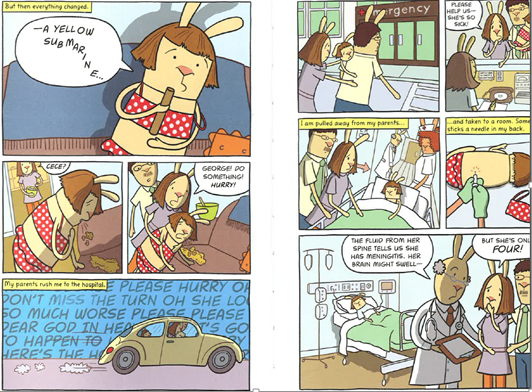
|
The first page shows Cece as a little girl playing in the 70s and doing things that kids do. The second page, shown above, explains how Cece contracts meningitis and loses her hearing. In graphic novels, students need to read the illustrations (standard 7) and create inferences (standard 1) from the few words that have been used and from the structure of the panels (standard 5).
Often times, the larger the panel, the more time has passed. Students can critique (standard 5) and infer (standard 1) how this structure affects meaning. For example, why are the scenes depicting the trip to the hospital and the doctor speaking to the parents both in such large panels? How are the parents feeling in these scenes? Why is time going so slowly?
The size and location of the font also tell a story (standard 5). Why is the word “submarine” slanted downward? Why does text serve as the backdrop of the panel where Cece is being rushed to the hospital?
Because vocabulary is limited, words and figurative language are typically not explained or elaborated upon. Students must interpret words and phrases (standard 4) through content, illustrations or further discovery.
Students may not be familiar with meningitis, the 70s or hearing loss. Providing opportunities for students to ask questions, research, validate and compare different digital texts (standards 7, 8 and 9) provides opportunity for critical thinking and autonomy.
NPR’s interview with Cece Bell (standard 7) offers insights into her book and her childhood. Students can assess whether the text aligns with her interview (standards 8 and 9).
El Deafo is more than just a story of a little girl who lost her hearing. It teaches students about compassion, empathy and friendship. The themes (standard 2) of the story are developed throughout the book and are meaningful to students, especially those within the targeted age range—a time when students often face insecurities.
Graphic Novels and Extension Activities
To help build that compassion and empathy, YouTube has an excellent video (standard 7) about bullying people with disabilities from which students can make many inferences (standard 1). A simple “It Says, I Say and So” chart can help students focus on the key messages and inspire them to think of additional applications.
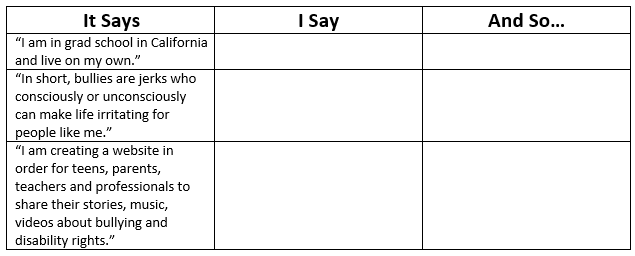
“It Says, I Say, And So” Chart |
Quotes taken directly from the video are placed in the “It Says” column. When I first introduce this activity, I provide quotes for the students. Later in the year after modeling a few times with a variety of texts, students can locate their own meaningful text.
The “I Say” is for student interpretation of the quote, and the “And So” is for inferences and outside connections and applications.
What better way to build empathy towards people with hearing loss than to walk in their shoes? Start ASL, a website that encourages people to start learning American Sign Language (standard 7), has videos demonstrating sign language for 150 words. Students can create a bully free slogan, or any concise message, using only sign language.
As a final project, students can demonstrate meaning and reflection from the text using the same structure as the graphic novel (standard 5). Website applications such as Bitstrips, ReadWriteThink or Comic Master let students create their own comic panels. Students learn first-hand how to portray a message through illustrations and use carefully chosen, concise text (standard 4).
Projects like this one where students must research facts, synthesize information, choose appropriate language and illustrations, and publish electronically touch on nearly all of the Common Core Writing standards, too!
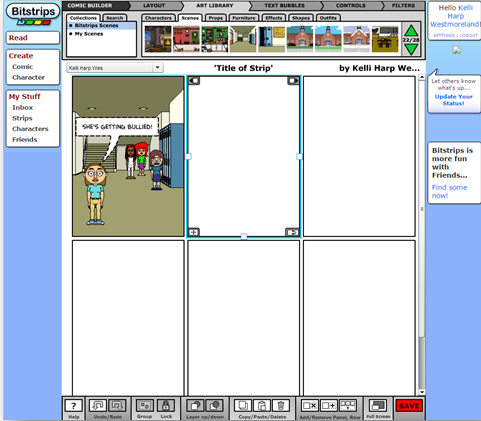
Bitstrips |
Graphic novels build confidence in readers and lend themselves to numerous higher level thinking strategies and activities. I used to associate graphic novels with superheroes and villains, both of which I am not a fan. I couldn’t have been more wrong about the range of graphic novels that exist. There are graphic novels that tell the story of classics like Shakespeare’s Romeo and Juliet (Grades 9-12), favorites such as Coraline (Grades 3-12) and The Lightning Thief (Grades 5-8), and informational texts for the content areas including The 9/11 Report: A Graphic Adaptation (Grades 10-12) and Lessons in Science Safety with Max Axiom, Super Scientist (grades 3-7, Level U, Lexile 610). All of these are perfect to engage readers, model standards and create a non-threatening culture in the classroom.
Booksource Recommendations


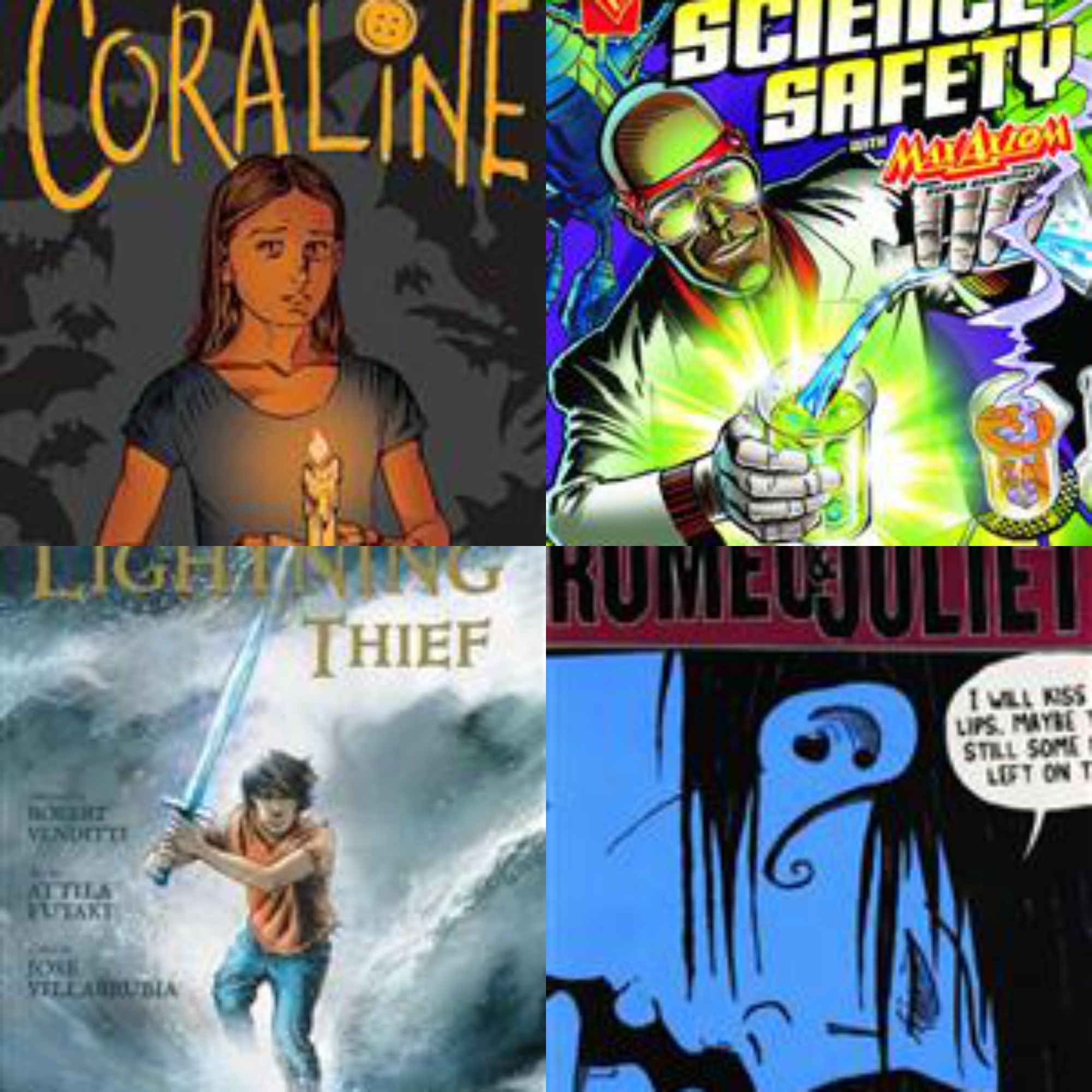
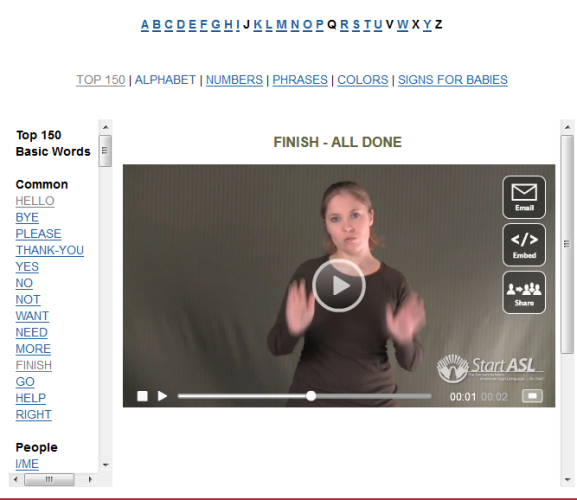
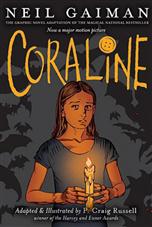
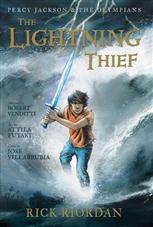
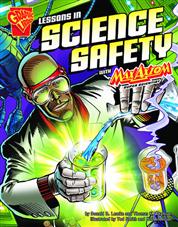
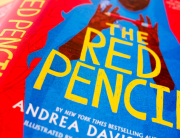

I am very thankful for your efforts put on this report.
This article is very informative, updated and transparent.
Can I expect you will post this sort of some other article in near future?
King regards,
Mead Valenzuela